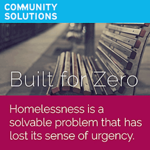Big Data Solutions to Prevent Homelessness
Published Jul-10-19Breakthrough:
Advances in data analytics are helping to get people off the streets.
Company:
Built for Zero, United States
The Story:
 Homelessness is a blight on the lives of those who have no roof over their head and a huge problem for society to contend with. It is a hugely complex issue, but one that is possible to solve. One solution that is starting to make an impact in several locations across the United States uses a big data approach to help people find homes.
Homelessness is a blight on the lives of those who have no roof over their head and a huge problem for society to contend with. It is a hugely complex issue, but one that is possible to solve. One solution that is starting to make an impact in several locations across the United States uses a big data approach to help people find homes.National Change
Built for Zero is a US nationwide program committed to ending homelessness by focusing attention on veterans and chronic homelessness. According to figures, approximately 84,000 Americans experience chronic homelessness on any given night.
Communities taking part in Built for Zero gather real-time data on homeless people to optimize local housing resources, accelerate the spread of strategies that work and monitor progress.
With clearer insights into the real picture on the ground, agencies are better able to intervene and help people into housing. Until recently, many cities in the US had little information about the homeless in their neighborhoods, relying solely on annual census data to inform their decision making. But with big data and software analytics, they now have access to real-time person-specific data on the problem. Built for Zero’s program creates a dashboard with seven key data points for each homeless individual and shares this with relevant agencies.
“Homelessness isn’t just a housing, public health or policy issue,” said Lindsey Giblin, lead at Built for Zero. “It’s also a data issue. Local leaders need current, accurate data to tackle the issue head on.”
Positive Results
The Built for Zero initiative says it has helped three municipalities end chronic homelessness. Additionally, nine US cities claim to have ended homelessness among military veterans and more than 38 participating communities are seeing measurable reductions in homelessness every month.
Predictions
Over in the UK, Professor Vania Sena from the University of Essex is working with local councils to prevent homelessness by using big data to predict when people need help.
Her approach uses data analysis and predictive algorithms to identify individual households that may require extra support as well as communities that are under pressure. Local authorities can then work with identified communities on a set of interventions.
Prof Sena and her team receive no information about specific individuals but the results they come up with can be mapped back to council records to predict who is most likely to need housing support. The analysis is based on an individual's financial standing with the council and their use of council services.
Better Than a Cure?
Preventing homelessness is not only beneficial to individuals but also to the public purse. According to Crisis, the UK national charity for homeless people preventing 40,000 people from becoming homeless could save the taxpayer £370 million (approximately $USD 470 million) per year.
Many councils and other government authorities in several counties are looking closely at data initiatives to end homelessness and if they continue to make a big impact on numbers we can expect greater adoption of a data-led approach.
Next Story »


